Neotibicen resonans photos by Joe Green from 2007, taken in Florida.
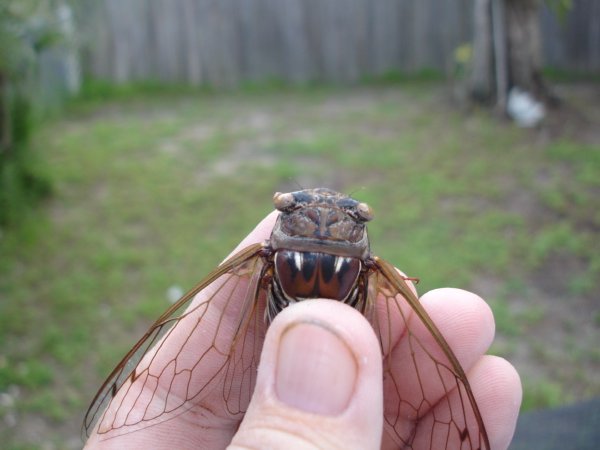
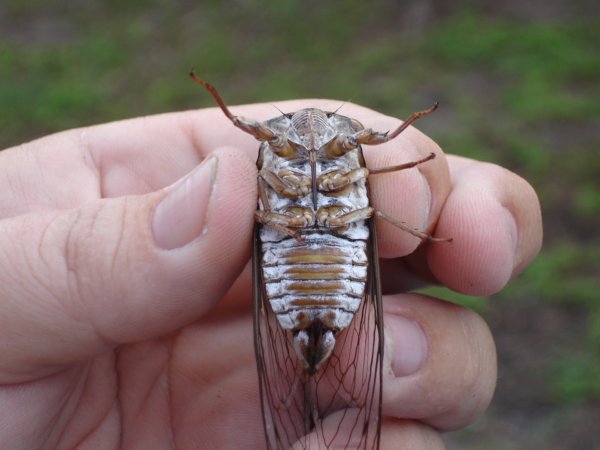
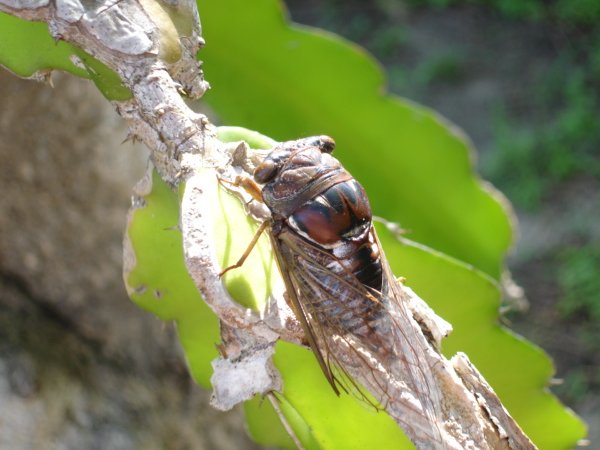
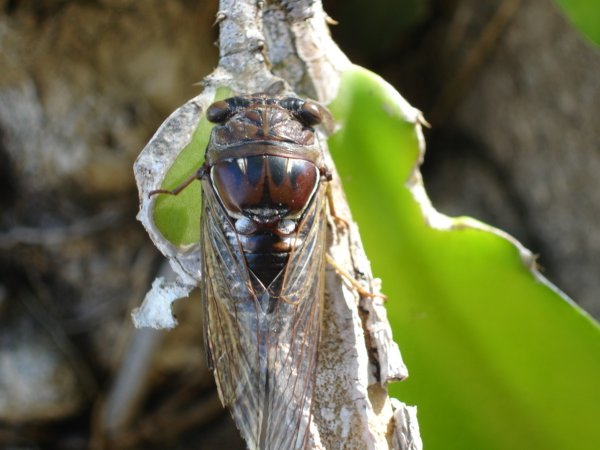
Neotibicen resonans photos by Joe Green from 2007, taken in Florida.




Megatibicen cultriformis (Davis, 1915), aka the Grand Western Flood Plain Cicada, is large cicada found in the states Arizona and New Mexico in the U.S. and in Mexico. According to the Biogeography of the Cicadas (Hemiptera: Cicadidae) of North America, North of Mexico by Allen F. Sanborn and Polly K. Phillips, it is found in the Mexican Highland Section of the Basin and Range Province of the Sonoran Desert, and is associated with cottonwood and willow trees1.
Over the weekend, cicada collector Richard Newfrock emailed me some cicada photos for identification. Amongst those photos was what appears to be Megatibicen cultriformis labeled Escondido, Cal[iforia]. I asked Richard about the location, and sure enough, he said they were found in a pool in Escondido. I double-checked the species and location with top-tier cicada experts Jeffery Cole and David Marshall. From our conversation, I believe they agreed that the cicadas appeared to be M. cultriformis and that Escondido is far from its normal range (about 400 miles away).
Female (left), Male (right). Found floating in a pool.

So, how did these cicadas Megatibicen cultriformis end up in Escondido? More than likely, if they are truly M. cultriformis, they hitchhiked on a tree transported from Arizona to California — or as David Marshall said to me in an email, “it’s at least possible that cultriformis could have been introduced on the roots of saplings transplanted from Arizona”.
Does anyone in the Escondido area want to listen for these cicadas in the summer and report back to us if you hear them?
Listen to its song:
Source: ©Insect Singers
Scientific classification:
Family: Cicadidae
Subfamily: Cicadinae
Tribe: Cryptotympanini
SubTribe: Cryptotympanina
Genera: Megatibicen
Species: Megatibicen cultriformis (Davis, 1915)
William T Davis’s description from A New Cicada from Arizona2:
Resembles Cicada marginata Say [now called Megatibicen pronotalis walkeri Metcalf, 1955] in size, color, and markings. Head black with an oblong greenish yellow spot each side between the eyes and a small spot of the same color on the front just above the transverse rugae. Pronotum greenish yellow with a large, conspicuous black spot occupying the fore part of its central area. The hind margin of the pronotum (collar) is entirely unicolorous as in marginata. The mesonotum is black, with a pruinose band each side at the base of the wings; the elevated x is greenish yellow, and there are two conspicuous, irregularly formed (pipe-shaped) greenish yellow spots occupying its central portion. The tergum is black, each side broadly margined with pruinose, and the segments have their posterior margins yellowish. There is also an indication of a dorsal line of pruinose spots on the tergum, which in the type have been nearly worn off. Beneath the head is blackish, the remainder of the insect being greenish yellow and more or less pruinose. The costal margin of the fore wing is entirely greenish yellow, darkened beyond the middle, and the w-mark is inconspicuous. Both fore and hind wings are greenish-yellow at base, with the veins darkened beyond the middle.
Note that greens often fade to tannish colors after a cicada dies.
Trivia: In Latin, “cultr” means knife, and “form” means shape — cultriformis means knife-shaped. Davis named cultriformis because “uncus locks, which are s millimeters long in cultriformis, and when seen in profile are shaped like the blade of a pruning knife, hence the name.” The uncus is the male genitalia.
Megatibicen resh (formerly Neotibicen resh and Tibicen resh) is commonly known as the Resh Cicada because the markings on its back resemble the Hebrew symbol Resh “ר”. The Resh Cicada has been documented to be found in Arkansas, Kansas, Lousiana, Mississippi, Nebraska, Oklahoma, South Carolina, Tennesee, and Texas.
Most people will discover them by finding their exuvia (shed skins, “shells”) on trees, or by their striking calls at sunset. I first encountered this cicada in Dallas, Texas near Pioneer Plaza (cattle sculptures). First I found the exuvia on oak trees (I needed a 3′ stick added to my 8′ reach to knock them down), and then at sunset I heard their call (which I mistook for M. auletes (which is not in Texas)). Listen to their song.
It is one of the smaller Megatibicen — maybe only M. dealbatus is smaller. Compare sizes using this image by Kathy Hill. Its compound eyes are gray-beige, with a black “mask” between the eyes, and its simple eyes are pink. Its ventral side is white and caramel colored. Its dorsal side is dominated by a light green color, with black, brown and white — forming a symmetrical camouflage pattern — which helps to hide the cicada in its arboreal habitat. Recently molted, golden pruinose shimmers on its head, pronotum, mesonotum, and abdomen.
During the molting process, up until the cicada’s body sclerotizes (hardens), the cicada’s body is leaf-green (camouflaged like a hanging leaf).
The exuvia of the Resh cicada is large and easy to spot, even high up in trees. Even though molted adults are closer in size to N. tibicen than M. auletes, the exuvia of M. resh is comparable to M. auletes, which is the largest cicada in North America.
More photos from this series: Megatibicen resh gallery.
Update: The hearing on the development of this property is May 14 at 7 p.m. but researchers can write testimony now and send it to Wallingford Planning and Zoning Commission, Wallingford Town Hall, 45 S. Main St., Wallingford, CT 06492.
Megatibicen auletes, the largest cicada in North America:
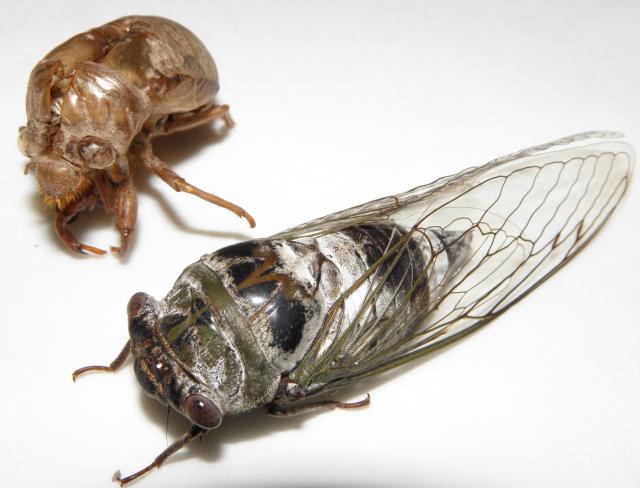
Anytime we remove trees, we reduce cicada habitat. Remove a small forest of trees and we might destroy the habitat for an entire species. North American cicada species need trees to survive and live out their life cycles, and certain cicada species require specific types of trees and specific environmental conditions. This is the case for Megatibicen auletes, also known as the Northern Dusk Singing Cicada, which prefers oak trees growing in sandy soil.
Megatibicen auletes habitat is in peril in Wallingford, Connecticut, where a rare sandplain is about to be excavated and turned into space for a warehouse. Read this article: Environmental concerns prompt questions of state oversight in Wallingford. After reading the article, it seems like there is still a chance to reverse plans to develop this area. I hope it does not happen, for the sake of the cicadas.
Megatibicen auletes is the largest cicada in North America. You can hear its remarkable call right after sunset in late summer months. I wonder how many residents of the Wallingford area knew that the largest cicada in North America lived in their community. I wonder how many people have heard the auletes’ scream right after sunset and wondered what creature made that sound. Hopefully, people will have another chance to hear them this summer, rather than the sounds of machines grinding up a forest, or the silence of yet another warehouse parking lot.
Today is September 21st, 2017 — the last day of Summer, in central New Jersey. Leaves of maple trees have started to turn scarlet and yellow. Oaks are dropping their acorns. The few, remaining Morning (Neotibicen tibicen tibicen) and Linne’s (Neotibicen linnei) cicadas sound decrepit and tired — like tiny breaking machines, low on fuel and oil. I found one dead Morning cicada lying on a sidewalk — its body crushed. Here in New Jersey, at least, the cicada season is all but over.
Molting Neotibicen tibicen tibicen in Little Silver, NJ. August 26st.
As cicada years go, this one had ups and downs. It wasn’t as awesome as 2016, but I can’t blame the cicadas.
Downs:
Ups:
Here’s some images from this summer:
Neotibicen tibicen tibicen with bad wing. The indigo color is fascinating. August 9th.
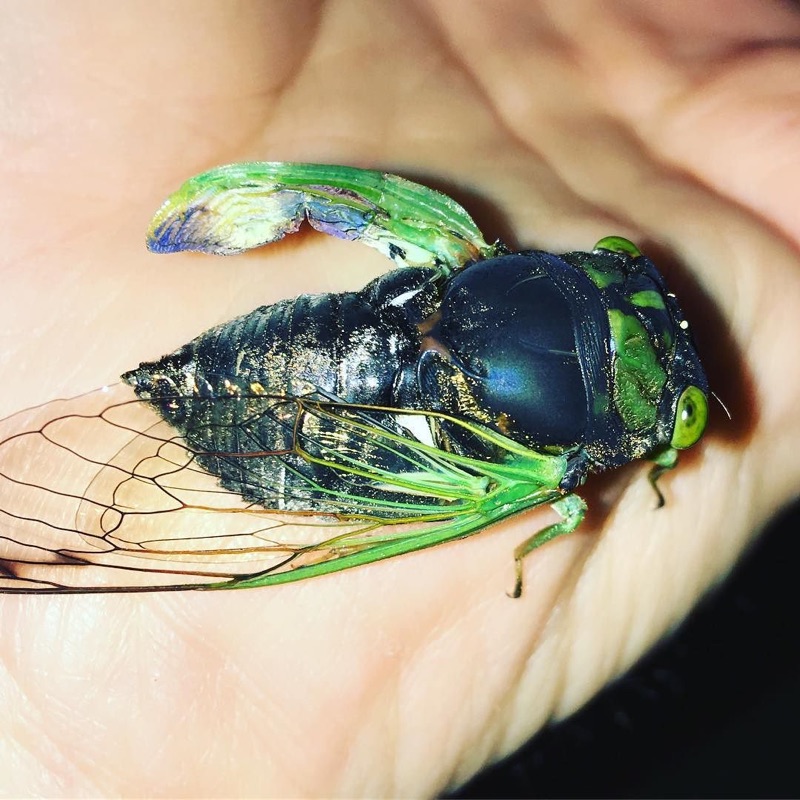
A Neotibicen tibicen tibicen found during a lunchtime stroll. September 1st.
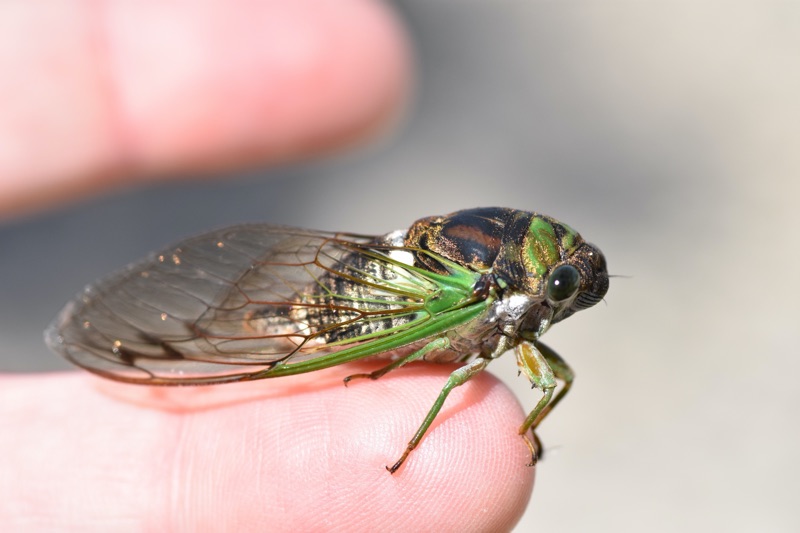
A female Neotibicen canicularis or maybe pink N. linnei found in Little Silver, NJ. August 25th.
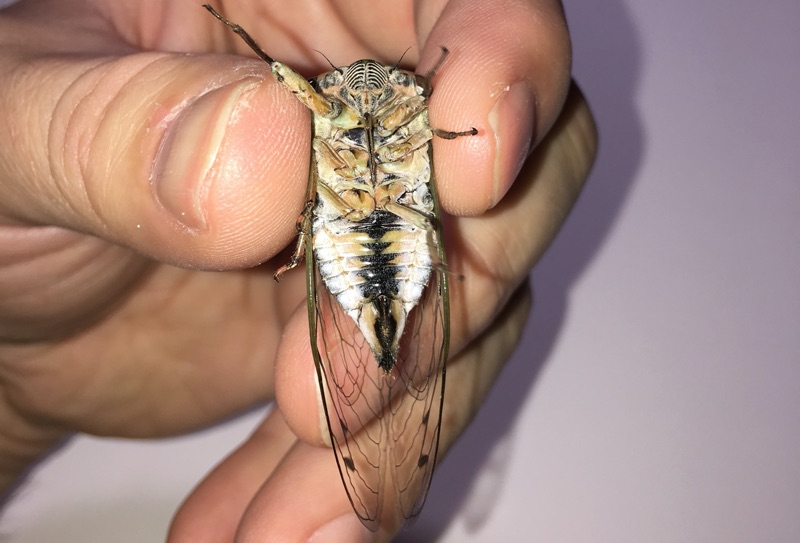
You’ll find more activity on the Facebook page, Twitter, and Instagram.
And last, the most popular post on the Cicada Mania Facebook page:
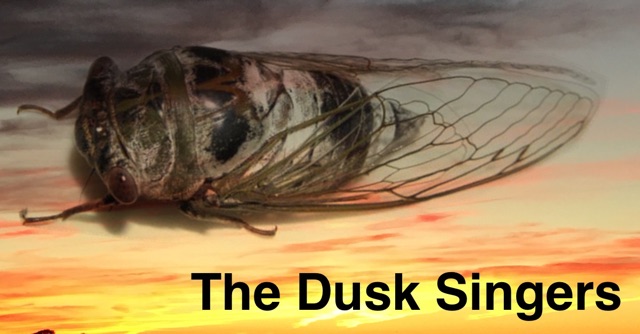
Dusk is the time of day between sunset and night. Many species of Megatibicen & Neotibicen (formerly Tibicen) sing at this time. I’m not sure why they sing at this time — perhaps it helps them avoid audio competition with other singing insects, or perhaps it helps them avoid predators by calling at this specific time of the day.
If you find yourself outdoors in the eastern half of the U.S. after sunset and hear a cicada call, it is likely one of the following Megatibicen or Neotibicen species:
Megatibicen are LARGE and LOUD cicadas.
Megatibicen auletes aka the Northern Dusk Singing Cicada. This cicada can be found in these states: AL, AR, CT, DE, DC, FL, GA, IL, IN, IA, KS, KY, LA, MD, MA, MI, MS, MO, NE, NJ, NY, NC, OH, OK, PA, SC, TN, TX, VA, WV, WI. Season: July to Fall.
M. auletes Call*:
Megatibicen figuratus aka the Fall Southeastern Dusk-singing Cicada. Found in: AL, AR, FL, GA, LA, MS, NC, SC, TN, TX, VA. Season: July to Fall.
M. figuratus Call*:
Megatibicen resh aka Resh Cicada aka Western Dusk Singing Cicada. Found in: AR, KS, LA, MS, NE, OK, SC, TN, TX. Season: July to Fall.
M. resh Call*:
Megatibicen resonans aka Southern Resonant/Great Pine Barrens Cicada aka Southern Dusk Singing Cicada. Found in AL, FL, GA, LA, MS, NC, SC, TN, TX, VA. Season: July to Fall.
M. resonans Call*:
Medium-sized, green cicadas with calls that sound like the rhythmic grinding of a scissor on a sharpening wheel (not a common tool in the 21st century).
Neotibicen pruinosus pruinosus aka Scissor(s) Grinder. Found in AL, AR, CO, IL, IN, IA, KS, KY, LA, MI, MN, MS, MO, NE, OH, OK, SC, SD, TN, TX, VA, WV, WI. Season: June – September. Neotibicen pruinosus fulvus aka Pale Scissor(s) Grinder Cicada. Found in: KS, OK. Season: June – September.
N. pruinosus Call*:
Neotibicen winnemanna aka Eastern Scissor(s) Grinder. Found in AL, DE, DC, GA, KY, LA, MD, MS, NC, NJ, PA, SC, TN, TX, VA, WV. Season: June – Fall.
N. winnemanna Call*:
*Audio files are Copyright of InsectSingers.com. Season information gathered from BugGuide.net.
A new species of Megatibicen, named Megatibicen harenosus sp. n., has been described by Jeffrey A. Cole. It lives in the Mescalero-Monahans shinnery sands areas of New Mexico and Texas. It is very similar to Megatibicen (Neotibicen, Tibicen) tremulus, which itself looks a lot like dorsatus and dealbatus.
Here’s a link to the announcement of the paper. This is the abstract:
Megatibicen harenosus sp. n. is described from the Mescalero-Monahans shinnery sands of New Mexico and Texas, U.S.A. The new species is diagnosed from similar species, especially M. tremulus which it resembles closely, by male genital morphology, color pattern, calling song, and ecology. Seven characters from the male calling song are described from analysis of field recordings, of which all four temporal song characters are significantly different from M. tremulus. With one of the most southwestern distribution of any Megatibicen species, M. harenosus is a new addition to the rich, endemic, and understudied Mescalero-Monahans shinnery sands biota. The possibility that M. harenosus and M. tremulus are sister species is raised. The ecological, biological, and evolutionary species concepts support species status for M. harenosus, and an hypothesis of peripatric speciation in peripheral isolation is advanced.
There is a sample of this cicada’s song on the Insect Singers website. Check it out.

For some reason I associate “Giga” with “Gigabytes” and storage media like Flash drives, which explains this joke image.
Over the past two years there have been quite a few updates to the genera of the cicadas that were organized under the Tibicen genus earlier this decade.
The most recent paper by Young June Lee introduces the genera Gigatibicen, Ameritibicen, and Paratibicen 1. Earlier this year there was a paper by Allen Sanborn and Maxine Heath that introduced the genus Megatibicen 3, and in 2015 there was a paper by Kathy Hill and others that introduced Neotibicen and Hadoa 2.
See the end of the article for links to these papers, and related articles on CicadaMania.com.
The table below shows the names/synonyms (sub species have been removed to keep the table compact):
| (Tibicen circa 2014) | Hill (2015)2 | Sanborn, Heath (2016)3 | Lee (2016)1 |
|---|---|---|---|
| Tibicen auletes | Neotibicen auletes | Megatibicen auletes | Gigatibicen auletes |
| Tibicen auriferus | Neotibicen auriferus | no change | no change |
| Tibicen canicularis | Neotibicen canicularis | no change | no change |
| Tibicen cultriformis | Neotibicen cultriformis | Megatibicen cultriformis | Ameritibicen cultriformis |
| Tibicen davisi davisi | Neotibicen davisi | no change | no change |
| Tibicen dealbatus | Neotibicen dealbatus | Megatibicen dealbatus | Ameritibicen dealbatus |
| Tibicen dorsatus | Neotibicen dorsatus | Megatibicen dorsatus | Ameritibicen dorsatus |
| Tibicen figuratus | Neotibicen figuratus | Megatibicen figuratus | Ameritibicen figuratus |
| Tibicen latifasciatus | Neotibicen latifasciatus | no change | no change |
| Tibicen linnei | Neotibicen linnei | no change | no change |
| Tibicen lyricen engelhardti | Neotibicen lyricen | no change | no change |
| Tibicen pronotalis pronotalis | Neotibicen pronotalis | Megatibicen pronotalis | Ameritibicen pronotalis |
| Tibicen pruinosus fulvus | Neotibicen pruinosus | no change | no change |
| Tibicen resh | Neotibicen resh | Megatibicen resh | Gigatibicen resh |
| Tibicen resonans | Neotibicen resonans | Megatibicen resonans | Gigatibicen resonans |
| Tibicen robinsonianus | Neotibicen robinsonianus | no change | no change |
| Tibicen similaris | Neotibicen similaris | no change | Paratibicen similaris |
| Tibicen superbus | Neotibicen superbus | no change | no change |
| Tibicen tibicen australis | Neotibicen tibicen | no change | no change |
| Tibicen tremulus | Neotibicen tremulus | Megatibicen tremulus | Ameritibicen tremulus |
| Tibicen winnemanna | Neotibicen winnemanna | no change | no change |
| Tibicen bifidus | Hadoa bifida | no change | no change |
| Tibicen chiricahua | Hadoa chiricahua | no change | no change |
| Tibicen duryi | Hadoa duryi | no change | no change |
| Tibicen inauditus | Hadoa inaudita | no change | no change |
| Tibicen longioperculus | Hadoa longiopercula | no change | no change |
| Tibicen neomexicensis | Hadoa neomexicensis | no change | no change |
| Tibicen parallelus | Hadoa parallela | no change | no change |
| Tibicen simplex | Hadoa simplex | no change | no change |
| Tibicen texanus | Hadoa texana | no change | no change |
| Tibicen townsendii | Hadoa townsendii | no change | no change |
Update (9/20): I guessed the species correctly: all the Large Flute Players.
Update (9/24): I neglected to note that there’s another paper out there by Young June Lee called Description of three new genera, Paratibicen, Megatibicen, and Ameritibicen, of Cryptotympanini (Hemiptera: Cicadidae) and a key to their species. Link to it here. This manuscript goes beyond one new genus, and instead introduces three: Paratibicen, Megatibicen, and Ameritibicen. Lee’s paper differs from Sanborn & Heath in that the large Neotibicen are spit into Megatibicen and Ameritibicen in Young’s document, but they’re all Megatibicen in Sanborn & Heath’s paper.
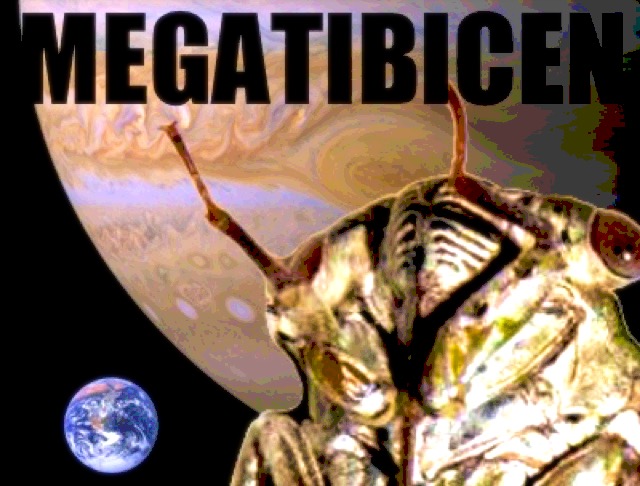
Last night I had a rough night’s sleep. I tossed and turned all night long. I remember looking at the clock and seeing 4 am, and thinking “tomorrow is ruined”. Sometime during the night I dreamt of finding thousands of molted Neotibicen exuvia clinging to shrubbery — a rare if not impossible sight in real life.
When I woke I checked my email and found a communication from David Marshall. David is well known and respected in the cicada world for many things including describing the 7th species of Magicicada with John Cooley, as well as being part of the team who defined the Neotibicen and Hadoa genera (link to paper)1.
David wrote to let me know that Allen F. Sanborn and Maxine S. Heath had published a new paper titled: Megatibicen n. gen., a new North American cicada genus (Hemiptera: Cicadidae: Cicadinae: Cryptotympanini), 2016, Zootaxa Vol 4168, No 3.(link).
So, what is MEGATIBICEN? Assumptions after the abstract.
Here is the abstract:
The genus Tibicen has had a confusing history (see summary in Boulard and Puissant 2014; Marshall and Hill 2014; Sanborn 2014). Boulard and his colleague (Boulard 1984; 1988; 1997; 2001; 2003; Boulard and Puissant 2013; 2014; 2015) have argued for the suppression of Tibicen and the taxa derivatived from it in favor of Lyristes Horváth. Boulard’s argument for suppression was first described in Melville and Sims (1984) who presented the case for suppression to the International Commission on Zoological Nomenclature with further comments made by Hamilton (1985), Boulard (1985), and Lauterer (1985). A lack of action resulted in additional comments being published in 2014 again supporting the retention (Sanborn 2014; Marshall and Hill 2014) or the suppression (Boulard and Puissant 2014) of Tibicen.
My guess, without reading the document, is that Megatibicen includes the larger North America Neotibicen species, including the “auletes group” (M. auletes, M. resh, M. figuratus, M. resonans), the “pronotalis group” (M. pronotalis, M. dealbatus, M. cultriformis) and the “dorsatus group” (M. dorsatus, M. tremulus), or a mix of these. M. auletes is the largest cicada in North America. “Mega” is the Greek word for “very large” or “great”. Word is that Kathy Hill and David Marshall also planned on describing a Megatibicen genus at one point, as well.
Whenever cicada names change it causes feelings of bemusement, discontentment, and discomfort amongst some cicada researchers and fans. I know I don’t like it because I have to update the names of cicadas in 100’s of places on this website ;). Some folks simply disagree with the folks writing the paper. Some people prefer former names because they sound nicer (e.g. N. chloromerus vs N. tibicen tibicen). Some people simply do not like change.
Related: Here’s my article on when Neotibicen & Hadoa were established from Tibicen.
1 Hill, et al. Molecular phylogenetics, diversification, and systematics of Tibicen Latreille 1825 and allied cicadas of the tribe Cryptotympanini, with three new genera and emphasis on species from the USA and Canada (Hemiptera: Auchenorrhyncha: Cicadidae) 2015, Zootaxa 3985 (2): 219—251.
Megatibicen tremulus Cole, 2008
Source: ©Insect Singers | Species: M. tremulus
Playlists contain multiple videos found on YouTube.
Family: Cicadidae
Subfamily: Cicadinae
Tribe: Cryptotympanini
Subtribe: Cryptotympanina
Genus: Megatibicen
Species: Megatibicen tremulus Cole, 2008